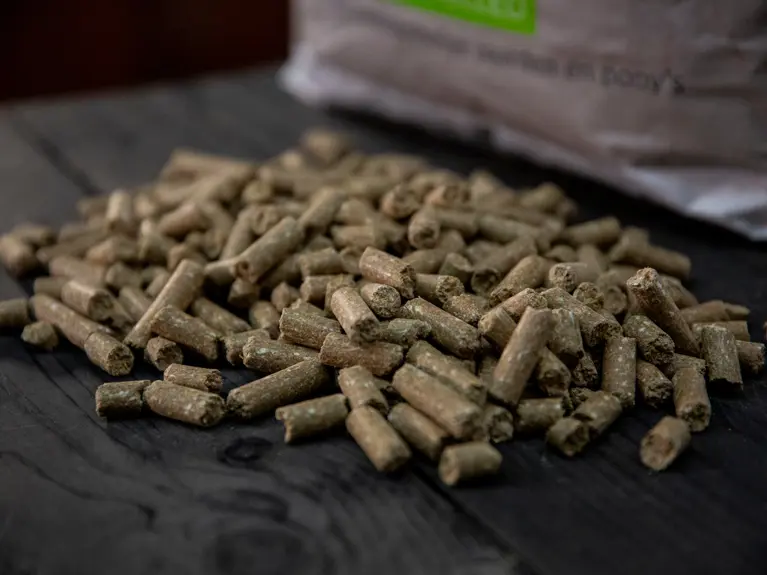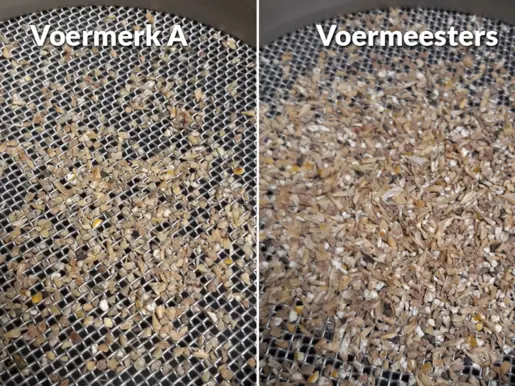
Taking a closer look at the structure of dutch horse pellets
Every horse owner knows that horses and ponies need a daily portion of fiber-rich forage in the form of grass, hay, or a forage mix. But to truly complete the equine menu, good-quality concentrates are essential. Pellets and/or muesli provide your horse with sufficient minerals, vitamins, and trace elements. Pellets vary enormously in composition, pellet size, and structure. Voermeesters commissioned an analysis of pellets from eight different Dutch brands, focusing on structure and fiber size. Why we did this, and what the results were, you can read below.
Making the perfect horse pellet is work for specialists
Each type of horse pellet is made from a unique mix of raw materials, designed to meet the nutritional needs of different horses and ponies. Concentrates are always a blend of ingredients. Some raw materials, such as maize and barley, require special treatment before they can be properly digested, such as fine grinding or heat processing. Only after this preparation can horses digest the starch in maize and barley.
On the other hand, oats that are ground too finely form a sticky paste in the horse’s stomach, similar to wallpaper glue. This is extremely difficult for the digestive system to process. That is why producing high-quality pellets requires skilled specialists.
Horses are natural fiber eaters
Horses obtain fiber from forage such as grass, hay, silage, or alfalfa. As shown in the image above, fiber digestion takes place only in the large intestine. This process, called fermentation, involves microorganisms, bacteria, fungi, and protozoa, that break down fibers into energy in the form of volatile fatty acids.
This process takes time, but the slowly released energy is, by nature, the horse’s most important energy source. Horses and ponies use these fatty acids, for example, to maintain their body temperature.
A horse only swallows a mouthful of forage once the grass fibers have been chewed down to a size of about 1–4 mm in length and 2 mm in diameter. That may sound small, but compared to the fiber particles found in an average Dutch pellet, these pieces are still relatively large.
Vertering van voedingstoffen vindt plaats in de darmen
Many people think that most nutrients are extracted from feed in the stomach, and that the rest of the digestive tract is mainly responsible for producing the countless manure balls you clean out of the stable each day. Nothing could be further from the truth, as you can see above. Horses actually digest the majority of nutrients in the intestines, which in adult horses can be up to 40 meters long. Fiber is digested last, in the cecum and large intestine. This makes it crucial that concentrates are digested all the way through to the large intestine. The closer the structure and fiber size of the concentrate resemble that of grass, the greater the likelihood of complete digestion. And the more nutrients your horse can extract from its feed.

Feed particles examined in an independent study
Matching the fiber size of pellets as closely as possible to that of finely chewed grass is ideal for maximizing energy release. But how large are the fiber particles in an average Dutch horse pellet? Voermeesters investigated this in collaboration with Schothorst Feed Research in Lelystad.
This institute carried out an analysis (wet sieving method) on the eight best-selling basic pellet brands in the Netherlands, including those of Voermeesters. The conclusion? In seven out of eight cases, Dutch horse pellets turned out to be very finely structured. The table below shows the particle size distribution of the sieved pellet samples:
| Sieved particle size | Average horse pellet | Pellets Voermeesters |
| < 0.2 mm | 52,54% | 46,68% |
| 0.2 tot 1mm | 33,96% | 24,55% |
| > 1mm (similar to chewed grass) | 13,50% | 28,77% |

What doe your horse gain from extra-large, fiber rich pellets?
The first question you may want answered is: “How large are large pellets, exactly?” In the Netherlands, the average pellet has a diameter of 5 to 8 mm. Some brands, including Voermeesters, produce larger pellets, namely 10 mm. Horses need to chew longer on larger, fiber-rich pellets. This not only helps prevent esophageal blockages, but also ensures that the pellets are thoroughly ground down and that plenty of saliva is produced. This combination supports optimal digestion. Digestion begins in the mouth (chewing and saliva production) and in the stomach, where enzymes begin breaking down the feed.
Enzymes are substances that break down nutrients into small energy particles and building blocks (in the case of proteins), which eventually reach every cell in your horse’s body via the bloodstream. Enzymes are released primarily at the beginning of the small intestine. The finer the chewed particles of protein, fat, and carbohydrates entering the small intestine, the more effectively the enzymes can interact with them. This allows for faster and more complete digestion of proteins, fats, and carbohydrates. Thorough chewing, and therefore faster digestion, is crucial, as feed remains in the small intestine for only about 1.5 to 2 hours (see image below). The better enzymes can act on finely chewed feed, the more nutrients your horse can extract from the pellets. By feeding large, fiber-rich pellets that require intensive chewing, you enable your horse to literally extract every possible nutrient from the feed.

Personal feeding advice from our specialists
Voermeesters does not only produce large, fiber-rich pellets. With Pure feed from Voermeesters, we also use raw materials that are GMO controlled and pure in origin. You can find more information on this in the article GMO-Controlled Horse Feed and on Pure feed. To guarantee the right structure and particle size, every raw material used in Voermeesters feed is processed separately. Mixing all raw materials together first and then grinding the entire batch is much faster and cheaper, but as you read above, it is far less effective for releasing nutrients in your horse’s digestive system.
Would you like more information about this study or about which type of feed composition is healthiest for your horses and ponies? Take a look at the different pellets available at Voermeesters in terms of energy levels. Or contact our specialists for tailored, no-obligation feeding advice for your horse.

